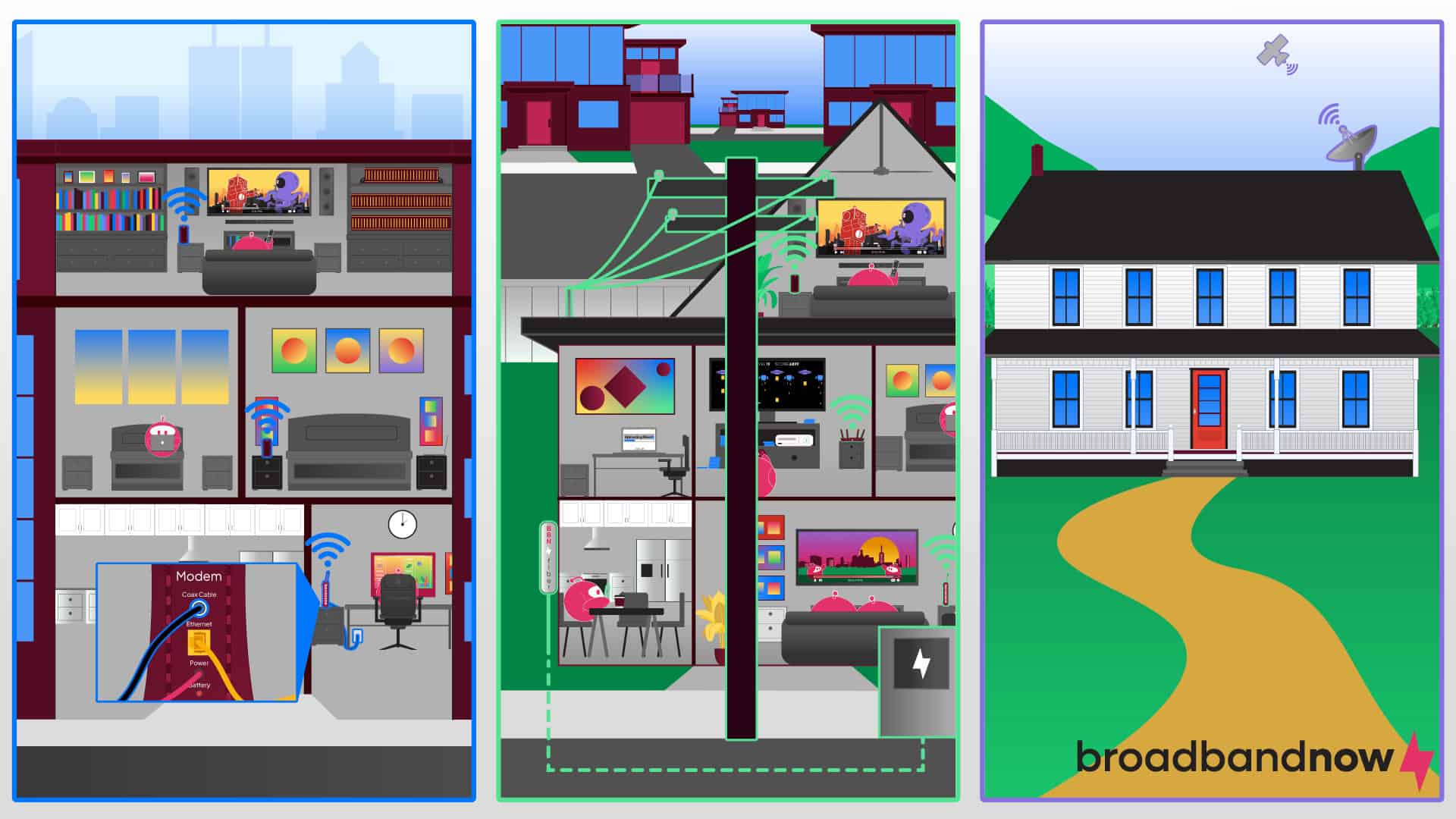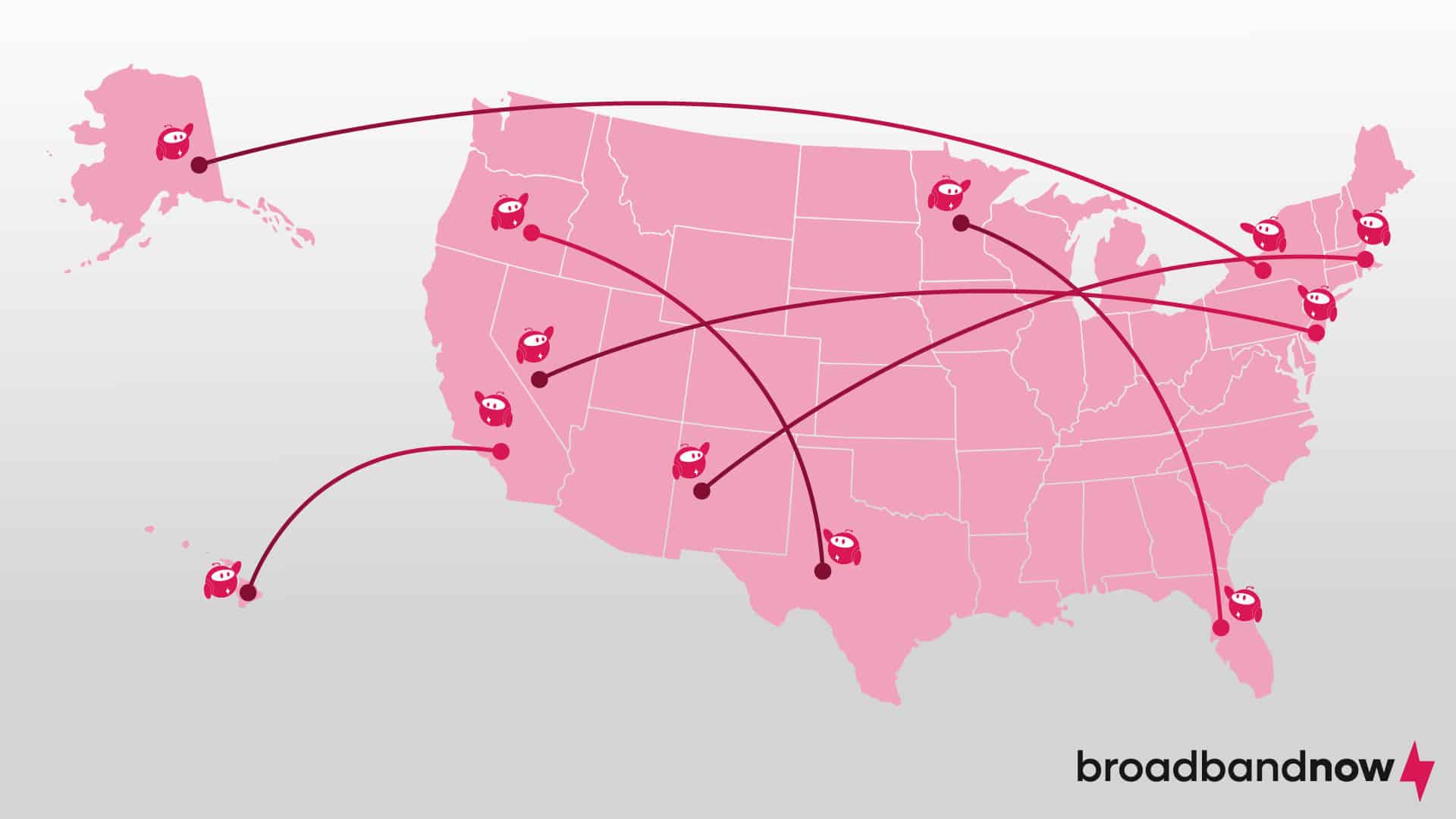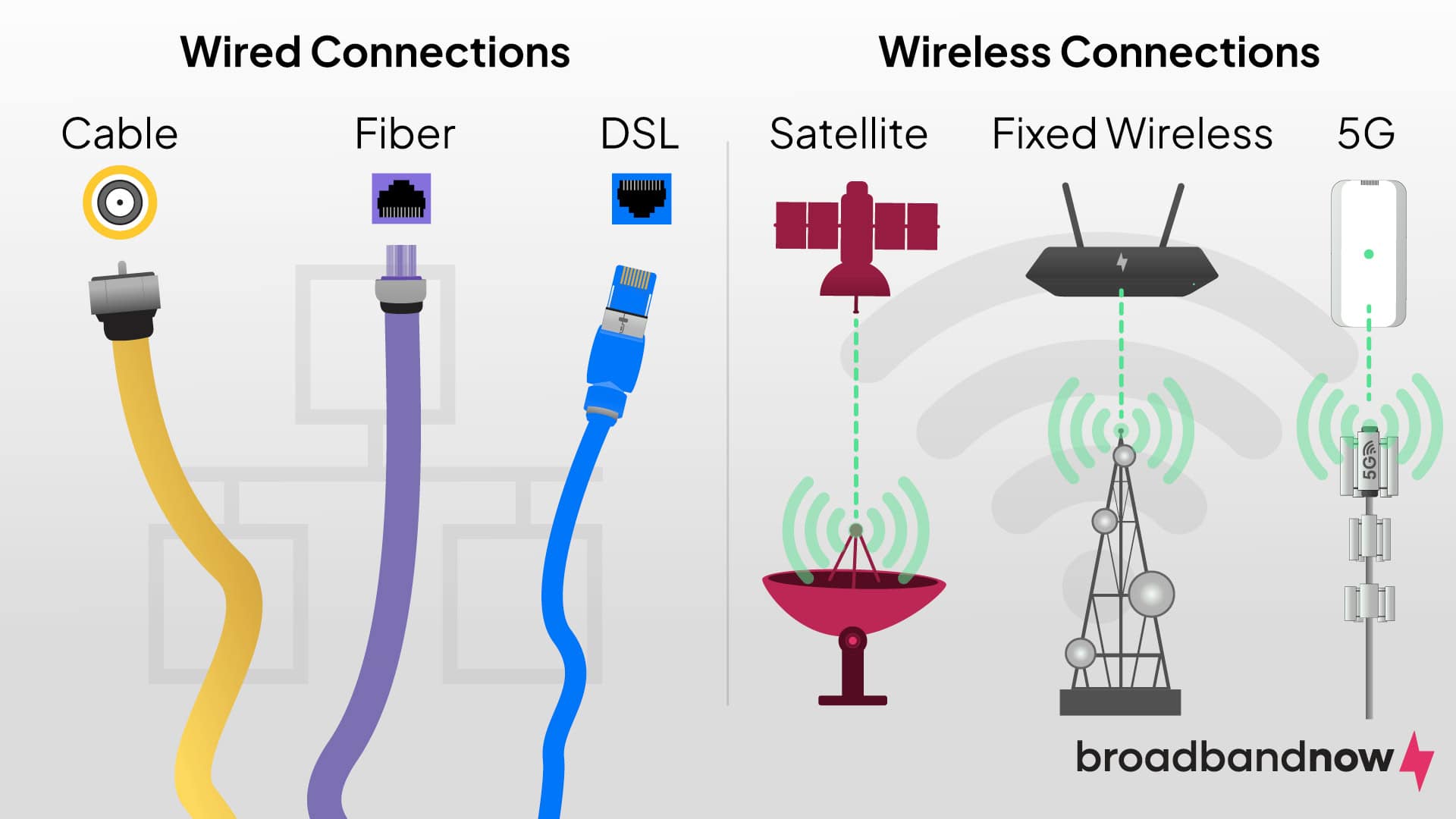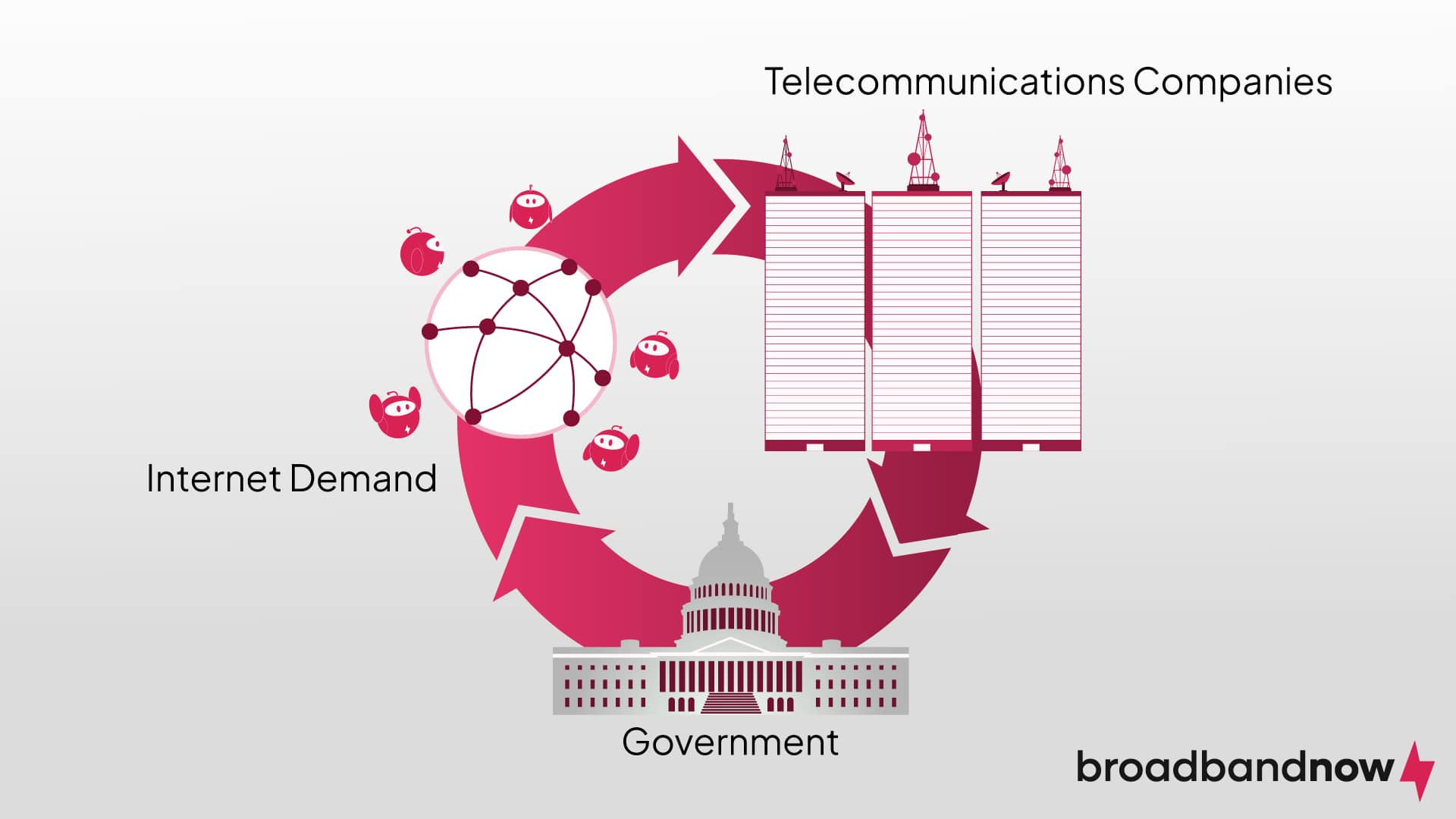What Is Broadband?
Explore broadband technology’s transformative impact on connectivity to bridge the digital divide.

- Broadband access is essential for driving innovation, economic growth, and job creation, playing a vital role in closing the digital divide and ensuring equitable opportunities for education and employment.
- Understanding the technical specifications and the Federal Communications Commission’s broadband criteria is crucial to making informed decisions about internet services.
- Broadband technology encompasses various types, such as DSL, cable, fiber-optic, satellite, and wireless — each catering to different needs.
Access to high-speed internet has become indispensable for how we run our lives. From working to paying bills to connecting with family and friends, the need for connectivity has only grown. At the heart of this digital revolution lies the concept of broadband, a term that has transcended its technical origins to become synonymous with fast, reliable internet access.
What is broadband, and why is accessing it so important? We’ve gathered everything you need to know about broadband and why learning about it matters.
Overview of Broadband
- What Is Broadband?
- What Are Common Broadband Myths?
- Why Are Broadband Internet Connections Important?
- How Does Broadband Work?
- What Are the Types of Broadband?
- Can You Use Broadband on Mobile?
- What Equipment Do You Need for a Broadband Connection?
- How Was Broadband Developed and Funded?
- What Are the Emerging Trends and Future of Broadband?
What Is Broadband?
Broadband technology is a highly advanced means of transmitting data that allows seamless and speedy internet access. Regulatory bodies, including the Federal Communications Commission (FCC) and the National Telecommunications and Information Administration (NTIA), recognize the crucial role of broadband in modern communication. The FCC defines broadband as an internet connection with a minimum download speed of 25 megabits per second (Mbps) and an upload speed of 3 Mbps. However, we suggest 200 Mbps as a minimum requirement for most modern households, especially considering the rapid evolution of internet activities and necessities.
What Are Common Broadband Myths?

Broadband technology is often shrouded in misunderstanding, leading to confusion for consumers. One such misconception is the assumption that any high-speed internet connection qualifies as broadband. By understanding the FCC’s definition of broadband as having a minimum download speed of 25 Mbps and an upload speed of 3 Mbps, you can see that not all internet connections meet the official broadband standards. Consumers should be cautious of services offering lower speeds that may not meet those standards.
Another common myth is that any connection labeled “high speed” is equivalent to broadband. In reality, different types of connections, such as DSL and satellite, may be marketed as high-speed, but they may not meet the FCC’s broadband criteria. You need to investigate the technical specifications of your internet services to ensure you are subscribing to true broadband with the specified minimum speeds. Through this research, you can avoid common pitfalls associated with assuming all high-speed services are equivalent to broadband and make informed decisions based on your internet needs.
Because broadband is held to a minimum speed standard, there’s a misconception that faster speeds are better. Higher speeds are advantageous for bandwidth-intensive activities such as streaming and online gaming, but not everyone’s internet usage requires maximum speeds. Selecting an internet plan that aligns with your usage and needs is critical to avoid overpaying for unnecessary bandwidth.
Why Are Broadband Internet Connections Important?

The impact of broadband access on the economy is immense because it plays a vital role in driving innovation, economic growth, and job creation. The lack of broadband infrastructure contributes to the digital divide, leading to disparities in opportunities and resources. Regions or communities with limited broadband access face obstacles to fully participating in the global economy, hindering their access to educational and employment opportunities. Closing the digital divide is imperative to ensure equitable economic development and empower individuals to succeed in an increasingly connected world.
Broadband access has far-reaching effects on daily life beyond internet browsing. Its importance is evident in education, health care, business, and entertainment. High-speed internet is essential in education, for instance, for online learning, accessing digital resources, and collaborating with peers. Telehealth is another area where broadband is transformative, enabling remote consultations, diagnostics, and monitoring. As digital technologies become more vital in society, the availability and quality of broadband services emerge as critical factors influencing the overall well-being and productivity of individuals and communities.
How Does Broadband Work?
As the demand for speedy and dependable internet access continues to grow, broadband technology stands as the essential foundation for implementing diverse infrastructures. DSL uses pre-existing telephone lines for data transmission, while cable broadband uses coaxial cables. Fiber-optic broadband, one of the fastest options, works by using optical fibers to transmit data. Satellite broadband operates through communication satellites orbiting the Earth, providing connectivity in remote areas. Wireless broadband offers internet access with mobility and flexibility, using radio signals.
Broadband connections are influenced by various critical components that determine their speed and efficiency. One essential component is bandwidth, which refers to the maximum rate of data transmission measured in Mbps. With higher bandwidth, download and upload speeds become faster. The increase in speed is important for activities such as gaming and streaming, which require more substantial bandwidths. Bandwidth and latency are closely related.
Latency, measured in milliseconds, represents the delay between sending and receiving data. Lower latency is vital for activities that require real-time responses, such as video conferencing and online gaming. Throughput is the speed of data transfer on your network. Network congestion, signal quality, and the efficiency of network protocols affect your overall throughput.
Broadband boasts numerous benefits, one of which is the ability to enable seamless engagement in various online activities, such as streaming high-definition content and participating in video conferences. Thanks to its high speeds, broadband is reliable and efficient for remote work, online education, and accessing cloud-based services. It is important to note, however, that higher costs may be associated with broadband compared to slower alternatives, making it less accessible for some.
What Are the Types of Broadband?

Different types of broadband internet connections cater to your diverse needs, providing options based on factors such as geographical location, speed requirements, and infrastructure availability.
- DSL: Digital subscriber line, or DSL, employs pre-existing phone lines to transmit data, presenting quicker speeds than a typical dial-up connection. Distance from the provider’s central hub, however, may affect the velocity.
- Cable: Internet service delivered through cable broadband is faster than DSL, thanks to coaxial cables. The connection speed may vary depending on the number of users accessing the service in the same location.
- Fiber: Fiber-optic broadband technology uses glass or plastic fibers to transmit data through light pulses. It’s the fastest and most dependable high-speed broadband option, with minimal latency.
- Satellite: Satellite broadband offers internet connectivity through communication satellites, making it a viable option for remote or rural areas that lack wired internet infrastructure. You may experience higher latency compared to alternative forms of internet access.
- Fixed wireless: Using radio signals, wireless broadband grants you the flexibility and mobility necessary for optimal internet accessibility, particularly on mobile devices.
- 5G home internet: By tapping into the modern 5G wireless network, you can access 5G internet speeds at home. The connections, however, will sometimes default to 4G speeds if the signal isn’t strong enough.
Can You Use Broadband on Mobile?
Wireless networks allow mobile devices to access broadband using 4G LTE and 5G technologies. You can access this high-speed internet on smartphones, tablets, and other portable gadgets with compatible built-in wireless capabilities or connect via a portable hotspot. You can activate mobile broadband through your device’s settings or by using a SIM card provided by your mobile carrier. The fast and reliable internet connectivity provided by mobile broadband makes it possible to use mobile devices for communication, entertainment, and productivity while on the go.
What Equipment Do You Need for a Broadband Connection?

The required equipment for establishing a broadband connection varies depending on the type of technology used.
- DSL: A DSL modem mediates between the internet and a computer or router by transforming the data into an understandable format. Occasionally, phone line filters are necessary to diminish interference from concurrent voice calls on the same line.
- Cable: This connection requires a cable modem to function as a go-between for the cable network and your devices by connecting to a cable outlet. Linking the cable modem to the wall requires a coaxial cable.
- Fiber: At your home, an optical network terminal (ONT) converts optical signals into electronic data. Ethernet cables help connect the ONT and the router, as well as establish connections to other devices directly.
- Satellite: A satellite dish is necessary to capture signals transmitted by communication satellites. A satellite modem connects to the dish, translating signals into usable data for internet access. The dish and modem are connected through coaxial cables to ensure seamless data transmission. You then need a router to connect multiple devices on your network wirelessly or through a wired connection. A stable power supply is crucial to ensure that components function properly.
- Fixed wireless: A Wi-Fi router acts as a conduit between the modem and various devices by wirelessly broadcasting internet signals. The power supply, meanwhile, functions as the energy source for the router.
- 5G home internet: A gateway device captures the 5G or 4G wireless signal from a nearby tower. The device usually also has the same functionalities as a router, providing wireless or wired connections to devices in your home.
How Was Broadband Developed and Funded?

The development of broadband technology has spanned several decades, driven by the increasing demand for faster and more efficient internet access. Advancements in telecommunications infrastructure led to the shift from dial-up connections to broadband in the late 20th century. The private sector, particularly telecommunications companies, invested in research, development, and infrastructure deployment to cater to high-speed internet needs. During the 1990s and 2000s, the focus shifted toward enhancing existing technologies such as DSL and cable broadband.
The government has played a crucial role in advancing broadband technology by addressing the digital divide and promoting universal access. Countries have implemented policies and funding programs to develop broadband infrastructure in rural and underserved areas. In the United States, initiatives such as the Affordable Connectivity Program, the Broadband Equity, Access, and Deployment Program, and the Connect America Fund by the FCC have been instrumental in shaping the broadband landscape. The programs provided, and in some cases continue to provide, financial support to service providers to expand infrastructure to areas lacking adequate coverage. Government-sponsored research and development projects have also contributed to technological innovations in broadband.
What Are the Emerging Trends and Future of Broadband?
What speeds are considered broadband varies greatly throughout not only the industry but also governing entities. BroadbandNow considers a stable broadband connection higher than the limits set by the FCC, but we’re not the only ones who disagree with the established limits. In the United States, some government representatives are already pushing to increase the minimum download speed to 100 Mbps. Even in other countries, the limit varies. The minimum broadband download speed in Canada, for example, is 50 Mbps.
As broadband technology evolves, there likely will be a push to increase the minimum speed requirements to establish the fastest internet connection for consumers. Speed is certainly at the forefront of the technology, but factors such as availability and security are sure to become key priorities as well.
Frequently Asked Questions About Broadband Internet
What is the difference between broadband and Wi-Fi?
The terms “broadband” and “Wi-Fi” are closely linked, but they have distinct differences. Broadband refers to fast internet access, which is achievable through various technologies, such as DSL or cable. The all-encompassing term includes the transfer of vast amounts of data at high speeds.
Wi-Fi refers to a specific wireless networking technology that allows devices to connect to the internet without needing physical cables. Wi-Fi functions within a broadband environment, creating a wireless network in a particular area that allows for seamless access to the internet by multiple devices, such as laptops, smartphones, and smart-home devices. Broadband describes a high-speed internet connection, while Wi-Fi enables the wireless distribution of that broadband connection in a specific range.
What are the different broadband speeds?
Broadband speeds are not uniform. Instead, they are distributed across a spectrum segmented by varying data-transfer rates. Deciding which broadband speed to choose depends on specific needs and requirements, including the number of devices connected, the type of online activities, and internet usage. Higher speeds typically support more bandwidth-intensive tasks, such as online gaming, streaming high-definition content, and large file downloads. The following list demonstrates the average available speed ranges for different types of broadband.
- DSL: 1 to 100 Mbps
- Cable: 25 Mbps to 1.2 Gbps
- Fiber: 50 Mbps to 10 Gbps
- Satellite: 25 to 330 Mbps
- Fixed wireless: 3 to 100 Mbps
- 5G home internet: 33 Mbps to 1 Gbps
What’s the difference between symmetrical and asymmetrical bandwidth?
The distribution of data-transfer rates between upload and download speeds in a broadband connection is known as symmetrical or asymmetrical bandwidth. Symmetrical bandwidth provides equal download and upload speeds, allowing for smooth transmission in both directions. The setup is especially advantageous for data-heavy tasks such as video conferencing, online gaming, and file-sharing.
Asymmetrical bandwidth is more common and involves varying upload and download speeds. In most residential broadband connections, download speeds are faster than upload speeds. This type of bandwidth is suitable for activities such as web browsing and content streaming, where you primarily consume data rather than upload large files. Choosing between symmetrical and asymmetrical bandwidth relies on specific usage patterns and requirements for individual users or businesses.
What does “the middle mile” mean in broadband?
Broadband networks are complex systems that rely on several stages of data transport. The intermediate stage between the internet backbone and end-user connections is commonly referred to as “the middle mile.” The middle mile includes the infrastructure and networks that move data across larger geographic areas, connecting regional and local networks to the internet backbone. That stage requires efficient data transit between central offices, data centers, or aggregation points to ensure reliable and effective connectivity across specific regions. While the last mile focuses on the local connections of end-users, the middle mile is vital for maintaining broadband networks’ overall robustness and speed by routing and managing data between different network nodes.
What are last-mile networks?
The final stretch of a telecommunications network that connects customers to their service provider’s infrastructure is known as the last-mile network. It’s a vital link in the chain, running from the local exchange or distribution point to individual homes, businesses, or end-user devices. The efficiency of the connection is crucial to delivering broadband services directly to consumers, influencing the overall quality and speed of internet access. Last-mile networks rely on various technologies, such as DSL, cable, and fiber-optic, to bridge the gap between the broader network infrastructure and end-users. The implementation ensures reliable and high-speed data delivery to individual homes or businesses.
Is broadband wired or wireless?
Broadband can provide high-speed internet access through both wired and wireless connections. Wired broadband includes physical cables such as DSL, cable broadband, and fiber-optic broadband, while wireless broadband uses radio waves or satellite signals for connectivity, enabling internet access without needing physical cables. Wireless technologies such as Wi-Fi, 4G, and 5G offer flexibility and mobility, while wired technologies generally deliver more stable connections and higher speeds.
Which type of broadband is best?
Selecting the ideal broadband type relies on factors such as usage needs, geographic location, and budget constraints. Fiber-optic broadband stands out for its reliability and exceptional symmetrical speeds, whereas cable broadband offers fast internet connections, particularly in urban settings. DSL provides an affordable option, although its speeds may be slower, especially in rural areas. Satellite broadband is an appropriate choice for remote regions with scarce alternatives. Wireless broadband, such as 4G and 5G, offers portability and versatility, but wired options may be quicker. The decision comes down to your needs and what’s available.